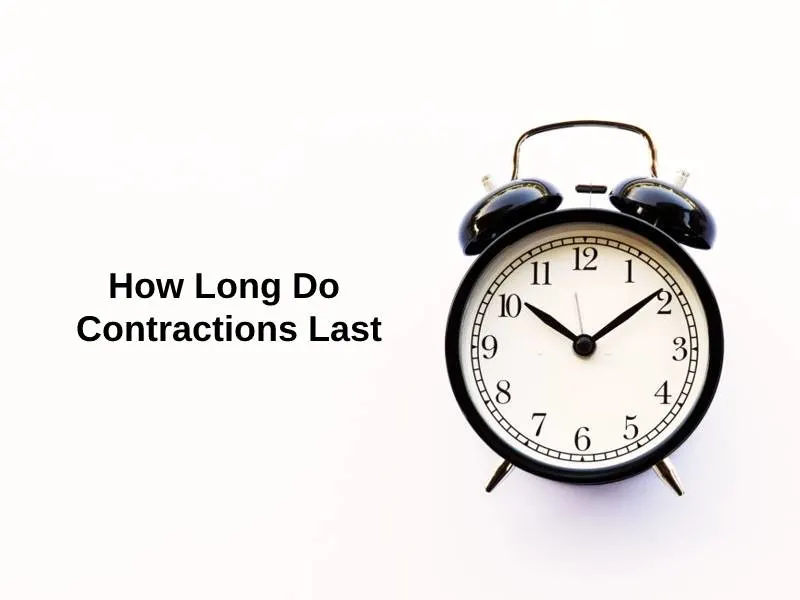Exact Answer: Up to 2 minutes
Labor is the biological process of bringing a new life into this world. It can last for up to 24 hours in case of the first child’s delivery. Contractions accompany labor in all the different phases and help in the delivery of the baby.
Contractions can be defined as the movement of uterine muscles at regular intervals of time, especially during labor. Although contractions are associated with labor, one can experience different types of them at different intensities and periods. Not all contractions lead up to real labor, some may also cause false symptoms resulting in false labor.
The main function of contractions is to help in childbirth by creating movements that push out the baby through the birth canal. It is a way of one’s body to tell that the baby is ready to arrive in this world. False labor is an indication of the arrival of a baby within a short period.

How Long Do Contractions Last?
Contractions can last for 30 to 70 seconds on average. It occurs at an interval of 5 to 10 minutes. True labor is experienced only when the contractions are strong and regular.
During contraction, the walls of the uterus tighten and loosen at regular intervals to help push the baby out. They tend to get stronger and closer with time as the mother prepares to deliver the baby. The mother can feel the pain in the belly and lower back to an extent that she might not be able to stand up.
The different types of contractions may include:
Early Contraction
The early contractions are mild and can be experienced at an early phase of labor. The tightening of the uterine muscles can last for 30 to 60 seconds. It is an organized contraction that gets closer with time up to a point when each contraction can be experienced only 5 minutes apart.
Active Labor and Transition Contraction
The contractions in this phase of labor are intense and painful. The abdomen area becomes very hard and the contractions last for 45 to 60 seconds. During the active labor phase, the cervix dilates up to 4 to 6 centimeters.
In the transition phase, the contractions are 60 to 90 seconds long and they occur at an interval of 30 seconds to 2 minutes. The cervix dilates up to 10 centimeters and may overlap as the body prepares to push the baby. Some symptoms that one may experience because of active labor and transition contraction includes:
- Nausea
- Lightheadedness and chills
- Vomiting
- Gas
Preterm Labor Contraction
Preterm labor contractions indicate pre-mature labor. It can be experienced before 37 weeks of pregnancy. These contractions occur for up to 60 seconds for over an hour, with intervals of 10 to 12 minutes.
Braxton-Hicks Contraction
Braxton-Hicks contractions are experienced in the fourth month of pregnancy and are also called false labor contractions. They are infrequent and irregular when compared to other types of contractions. They can last for anything between 30 seconds to 2 minutes.
In summary:
| Contraction | Time |
| Early | 30 – 60 seconds |
| Active Labor | 45 – 60 seconds |
| Transition | 60 – 90 seconds |
| Preterm Labor | 45 – 60 seconds |
| Braxton-Hicks | 30 – 120 seconds |
Why Do Contractions Last So Long?
One can experience the tightening and hardening of the stomach from the early stages of pregnancy. The body prepares itself for the stressful event of baby delivery. Contractions get stronger, longer, and more painful at the end of pregnancy to properly facilitate the arrival of the kid.
During the first stages of labor, the cervix starts to dilate with minor contractions. The contractions cause the cervix to get thinner and shorter to prepare for delivery. As the cervix dilates up to 6 centimeters, the contractions get stronger and more regular.
The active labor phase is also accompanied by vaginal discharge and can last for 4 to 8 hours. The transition period is comparatively shorter but more intense. During this period, the cervix dialates from 8 to 10 centimeters with the help of overlapping contractions.
Conclusion
Contractions are the movements of uterine muscles that last for anything between 30 to 120 seconds. These movements facilitate the delivery of the baby at the end phase of pregnancy. However, not all contractions lead up to true labor and are called Braxton-Hicks contractions.
Contractions occur in patterns with regular intervals in between. The intervals can be 2 to 12 minutes long. Contractions get intense at the end of the transition phase and may also overlap to obtain successful child delivery.